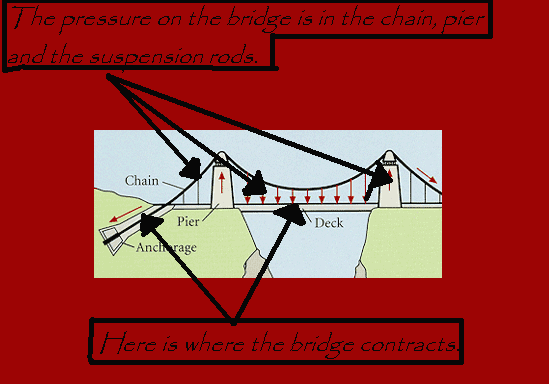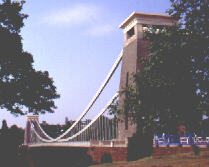
|
Bridging Europe |
|||||
| Bridge Disasters | Students Work | Bridge Game | Lessons | Email Your Bridge | |
The Clifton Suspension Bridge!
My name is Hannah Hay and I attend the International School of Toulouse. The bridge I have chosen to do my report on is the Clifton Suspension Bridge in Bristol.

The bridge was opened on Thursday 8th December 1864 and was designed by Isambaard Kingdom Brunel. It cost £75,000 to build this bridge which was a lot of money in 1864. The bridge goes over the Avon Gorge and is to Bristol what the Eiffel Tower is to Parris.
Some statistics of the bridge:
Total span between the towers: 214
meters
Width: 9.5 meters
Height above water level: 75 meter
Height of towers: 26 meters
Total weight: 1,500 tons
Number of links: 4,200
Number of suspension rods: 162
The principals of a suspension bridge: The weight of the deck is carried by the suspension rods. These pull down on the chain causing it to sag and to pull inwards at its ends. The downward force at each end is carried by the upward resistance of the stone piers. To prevent the chain from pulling inwards, it has to be anchored in solid rock.
The chains: The chains of the bridge are not chains as we usually think of them. Each link is made up of between 10 and 12 links of flat metal 7.6m (25 feet) long like huge spanners with closed ends, placed side by side and bolted together through the end holes. To achieve the correct profile of the bridge's chains, the bottom chains were first joined up as single links and adjusted for shape. Only after this were all the parallel links added to each section. The design of the joints between the links is of critical importance in minimizing the weight while maintaining strength.

The Saddles: When weight is placed on the bridge the chains sag very slightly. To accommodate this movement, and that caused by the expansion of the bridge in higher temperatures without placing extra load on the piers, each pier has two saddles to which the chains are bolted. These saddles adjust to the weight by moving on rollers. Land saddles perform a similar function where the chains reach ground level.
The
Anchorages:
The wrought iron chains of the bridge are anchored 21 meters
(70 feet) deep in the rocks at the side of the gorge. The end of the tunnel
tapers out in all directions, so that the brick infill forms an immovable plug.
Engineers Hawkshaw and Barlow used wrought-iron plate
girders and lattice cross girders for the structure of the deck. Brunel had
specified a timber framework with iron straps which would not have lasted so
well. Some of Brunel's timber and iron viaducts elsewhere have not survived.
The design of the bridge becomes even more remarkable when one considers it was built to carry traffic, pedestrians and animals, yet can cope with today's vehicles of up to 4 tons in weight. This durability is due in large part to the iron parapet on the outside of each footway which gives added stiffness and strength.


Here is the Clifton Suspension Bridge at night. The bridge has been illuminated in recent years, but in 1991 faults in the old lighting system made the trust buy a more modern lighting system. The strings of old lights were replaced by illuminated strips which were put down the suspension rods.

Some interesting facts about the bridge:
In 1885, a young woman called Sarah Ann Henley, tried to commit suicide by jumping off the bridge. The dress she had on was made of many layers of material so it acted as a parachute and broke her fall. She then live happily into her seventies.
The first aeroplane to fly under the bridge was that of Frenchman M. Tetard in 1911. In spite of a later ban on such escapades, in 1957 a pilot of 501 Sqn at nearby Filton took his Vampire jet beneath the bridge at a speed of 450mph, only to crash into the side of the gorge and perish in the fire that followed.
If you have any comments, suggestions or advice on how i can improve this web-page, email me on hay_h05@intst.net. Thanx.
